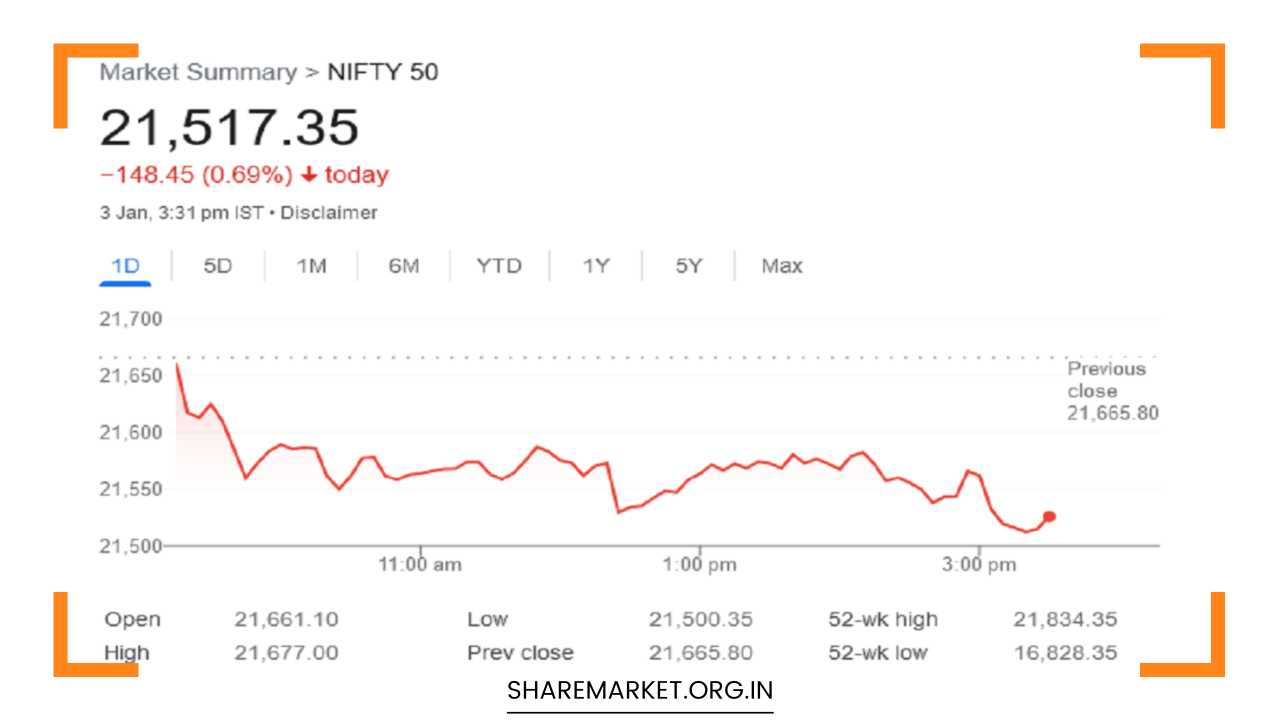Nifty Slipped Near 21500 Today: Nifty Prediction for Tomorrow

Nifty Prediction for Tomorrow
Market Analysis: Persistent Selling Pressure and Global Concerns Shake Indian Equities
For the second consecutive day, the Indian stock market witnessed significant selling pressure, as both the Sensex and Nifty closed with losses exceeding half a percent.
This downturn comes amidst a backdrop of global economic concerns, signaling caution among investors. Despite the overall market decline, a nuanced picture emerges with specific sectors showing resilience and opportunities for the discerning investor.
Market Overview:
The domestic equity benchmark indices, Sensex and Nifty, faced selling pressure, culminating in losses of more than half a percent.
Only a handful of shares on Sensex (10) and Nifty 50 (19) managed to close in the green, reflecting the widespread negativity that prevailed in the market.
However, a notable counter-trend emerged in the broader market, where out of the 3945 shares traded on BSE, 2137 closed with gains. This dichotomy suggests a nuanced market sentiment with discernible opportunities beyond the surface-level decline.
According to Vinod Nair, Head of Research at Geojit Financial Services, the market is grappling with a lack of fresh triggers, leading to concerns about valuations and exerting downward pressure.
Global Economic Concerns:
Vinod Nair points to global signals, particularly the contraction in manufacturing data in China and the Eurozone, which have escalated worries about the global economic recovery in the year 2024.
Investors are particularly sensitive to external factors influencing markets, and these global indicators have introduced an element of caution into the trading landscape.
The upcoming release of Federal Reserve minutes is anticipated to provide further insight into the future trajectory of the global economy.
The increase in the 10-year US bond yield and the rise in the dollar index, as highlighted by Nair, suggests that the Federal Reserve may deviate from the expected dovish stance.
This global context adds complexity to the market dynamics and prompts investors to carefully weigh their positions.
Market Performance:
In the recent trading session, Sensex recorded a decline of 535.88 points or 0.75 percent, closing at 71356.60. Similarly, Nifty 50 experienced a fall of 148.45 points or 0.69 percent, concluding the day at 21517.35.
Notably, Bajaj Auto emerged as the leading gainer on Nifty, securing a gain of 4.55 percent. In contrast, Hindalco was the top loser, experiencing a notable fall of 3.82 percent.
Analyzing individual stocks on Sensex, IndusInd Bank emerged as the top gainer with a rise of 1.69 percent, while JSW Steel faced the most significant decline, registering a fall of 3.76 percent.
These individual stock movements contribute to the overall narrative of a market grappling with diverse forces influencing different sectors.
Sectoral Trends:
Examining the market on a sectoral level reveals intriguing dynamics. Nifty IT witnessed a notable decline of 2.5 percent, reflecting the broader challenges faced by the information technology sector.
Nifty Metal also experienced a downturn of more than 1.5 percent, signifying a broader trend affecting metal-related industries.
Conversely, in the face of the overall market decline, Nifty Realty and Nifty PSU Bank demonstrated resilience by closing with gains of more than one percent each.
This sectoral divergence underscores the importance of a nuanced approach to investing, recognizing opportunities that may exist within specific industries despite the prevailing negative sentiment.
Outlook for January 4: Expert Opinions:
Looking ahead, market analysts offer insights into the potential trajectory for Thursday, January 4. Rupak Dey, Senior Technical Analyst at LKP Securities, observes that Nifty has breached its support level, slipping towards 21500.
This breach signals a weakening sentiment, and Dey suggests adopting a strategy of sell-on-rise, i.e., taking a sell position when the market rises. This cautious approach aligns with the prevailing uncertainty in the market.
Ajit Mishra, Senior Vice President of Technical Research at Religare Broking, offers a more balanced perspective. Despite weakness in critical sectors like banking and IT, Mishra views the ongoing correction in the market as healthy.
He recommends a strategy of buying on dips, emphasizing that as long as Nifty remains around the 21200 level, traders should consider opportunities for buying on market declines.
Mishra suggests that defensive sectors like Pharma and FMCG are currently attractive, advising traders to exercise caution and avoid aggressive long positions.
Prashant Tapase, Senior Vice President of Research at Mehta Equities, sheds light on the global factors influencing the market.
He notes that weak signals globally, such as the contraction in manufacturing data, have prompted profit booking for the second consecutive trading session.
Investors, exercising caution, are reducing holdings in stocks ahead of the US Federal Open Market Committee (US FOMC) meeting scheduled for Thursday.
Tapase highlights the contrasting trends in the market, where there was pressure on IT and metal stocks but a buying trend in power, realty, and oil and gas stocks.
The recent bullish trend in the market has led to expensive valuations, prompting investors to capitalize on this opportunity by selling shares.
Final Remarks:
In conclusion, the Indian stock market is navigating a complex landscape marked by persistent selling pressure, global economic concerns, and sectoral differentiations.
Investors are exercising caution, and the market is eagerly awaiting insights from the Federal Reserve’s minutes. As the market braces for potential volatility, opportunities may arise for those adopting a discerning and strategic approach.
The divergent performance across sectors underscores the importance of sector-specific analysis in identifying potential areas of strength and resilience.
As the market unfolds in the coming days, investors and traders alike must remain agile and responsive to evolving conditions.

















